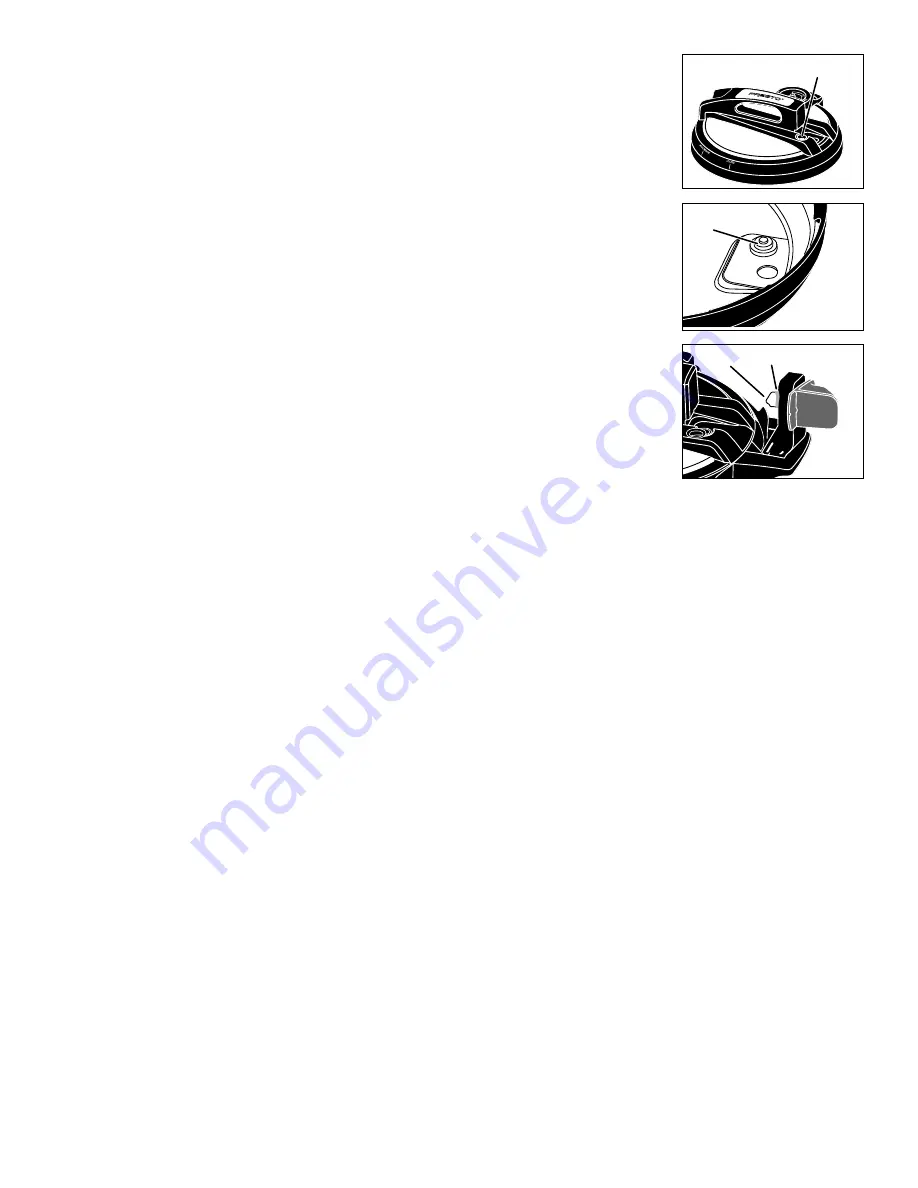
9
Occasionally
1. Remove the air vent/cover lock for cleaning. Place your finger over the top of the air vent/cover
lock on the cover (Fig. R) and remove the gasket from the underside of the cover (Fig. S). Push
the air vent/cover lock through the top of the cover. Wash it and the gasket in warm, soapy water.
The metal shaft may be cleaned with a nylon mesh pad. Clean the cover hole with a small brush.
After cleaning, reinsert the metal shaft from the top side of the cover down through the cover
hole. Place a finger over the top of the air vent/cover lock and push the gasket onto the end of
the metal shaft, fitting it into the groove.
2. Remove the gasket on the sensor (Fig. T) and wash it in warm, soapy water. Clean the sensor
with a damp cloth and place the gasket back on the sensor.
3. Wipe the outside of the cooker body with a damp cloth.
Care and Maintenance
♦ When not in use, store your pressure cooker in a dry place. To prevent unpleasant odors from
lingering, store the unit with the cover inverted on the cooker body.
♦ As is the case with all cookware, avoid chopping or cutting food inside the cooking pot with a
knife or other sharp utensil. Do not use metal utensils as they may scratch the nonstick surface.
♦ Do not strike the rim of the cooking pot with any cooking utensil. This could cause nicks in the
rim which may allow steam to escape and prevent the pressure cooker from sealing.
♦ The sealing ring and gasket for the air vent/cover lock may shrink, become hard, deformed,
cracked, or torn with normal use. When this happens, replace the sealing ring and/or the air vent/
cover lock gasket.
Leakage between the cover and cooker body is usually caused by deterioration of the sealing ring after prolonged use.
♦ Periodically check the vent pipe nut for looseness. If necessary, retighten with a ½ʺ wrench.
♦ If for any reason the pressure cooker cannot be opened, contact the Consumer Service Department in Eau Claire, WI at 1-800-877-0441.
♦ Any maintenance required for this product, other than normal household care and cleaning, should be performed by the Presto
Factory Service Department (page 22).
Helpful Hints
♦ Your favorite recipes may be adjusted for cooking in the pressure cooker by following the general directions in this manual. Use the
included timetables and recipes as a guide for specific foods and cooking times.
There is very little evaporation during pressure cooking, so the amount of liquid used should be decreased. A minimum of 1 cup of
water or cooking liquid should always be used for pressure cooking.
Of course, the easiest way to adapt your favorite conventional recipe is to find a similar recipe for pressure cooking in this book
and use it as a guide.
♦ Use the cooking rack when it is desirable to cook foods out of the cooking liquid. When foods are pressure cooked out of the liquid,
flavors will not intermingle. Therefore, it is possible to cook several foods at once, as long as they have similar cooking times. If it
is desirable to blend flavors, do not use the cooking rack.
♦ Many different cooking liquids can be used in a pressure cooker. Wine, beer, broth, fruit juices, and of course water all make excellent
cooking liquids in the pressure cooker.
♦ It is the size and shape of the food pieces, rather than the quantity, that affects pressure cooking time. For example, one potato will
have the same cooking time as six potatoes of similar size. It is important to note the size of the food specified in the cooking time-
tables; if the pieces of food being cooked are of a size different than those noted, it will be necessary to adjust the cooking time.
♦ If you have any questions on recipes, cooking times, or the operation of your pressure cooker, the Test Kitchen can be reached at
1-800-368-2194 or send an email via www.GoPresto.com.
Fig. R
Air vent/cover lock
Gasket
Fig. T
Sensor
Fig. S
Gasket






















